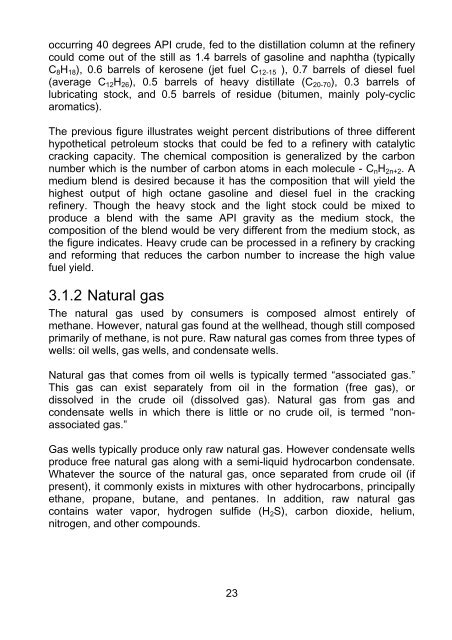Oil and gas production handbook An introduction to oil ... - ABB Group
Oil and gas production handbook An introduction to oil ... - ABB Group
Oil and gas production handbook An introduction to oil ... - ABB Group
Create successful ePaper yourself
Turn your PDF publications into a flip-book with our unique Google optimized e-Paper software.
occurring 40 degrees API crude, fed <strong>to</strong> the distillation column at the refinery<br />
could come out of the still as 1.4 barrels of <strong>gas</strong>oline <strong>and</strong> naphtha (typically<br />
C 8 H 18 ), 0.6 barrels of kerosene (jet fuel C 12-15 ), 0.7 barrels of diesel fuel<br />
(average C 12 H 26 ), 0.5 barrels of heavy distillate (C 20-70 ), 0.3 barrels of<br />
lubricating s<strong>to</strong>ck, <strong>and</strong> 0.5 barrels of residue (bitumen, mainly poly-cyclic<br />
aromatics).<br />
The previous figure illustrates weight percent distributions of three different<br />
hypothetical petroleum s<strong>to</strong>cks that could be fed <strong>to</strong> a refinery with catalytic<br />
cracking capacity. The chemical composition is generalized by the carbon<br />
number which is the number of carbon a<strong>to</strong>ms in each molecule - C n H 2n+2 . A<br />
medium blend is desired because it has the composition that will yield the<br />
highest output of high octane <strong>gas</strong>oline <strong>and</strong> diesel fuel in the cracking<br />
refinery. Though the heavy s<strong>to</strong>ck <strong>and</strong> the light s<strong>to</strong>ck could be mixed <strong>to</strong><br />
produce a blend with the same API gravity as the medium s<strong>to</strong>ck, the<br />
composition of the blend would be very different from the medium s<strong>to</strong>ck, as<br />
the figure indicates. Heavy crude can be processed in a refinery by cracking<br />
<strong>and</strong> reforming that reduces the carbon number <strong>to</strong> increase the high value<br />
fuel yield.<br />
3.1.2 Natural <strong>gas</strong><br />
The natural <strong>gas</strong> used by consumers is composed almost entirely of<br />
methane. However, natural <strong>gas</strong> found at the wellhead, though still composed<br />
primarily of methane, is not pure. Raw natural <strong>gas</strong> comes from three types of<br />
wells: <strong>oil</strong> wells, <strong>gas</strong> wells, <strong>and</strong> condensate wells.<br />
Natural <strong>gas</strong> that comes from <strong>oil</strong> wells is typically termed “associated <strong>gas</strong>.”<br />
This <strong>gas</strong> can exist separately from <strong>oil</strong> in the formation (free <strong>gas</strong>), or<br />
dissolved in the crude <strong>oil</strong> (dissolved <strong>gas</strong>). Natural <strong>gas</strong> from <strong>gas</strong> <strong>and</strong><br />
condensate wells in which there is little or no crude <strong>oil</strong>, is termed “nonassociated<br />
<strong>gas</strong>.”<br />
Gas wells typically produce only raw natural <strong>gas</strong>. However condensate wells<br />
produce free natural <strong>gas</strong> along with a semi-liquid hydrocarbon condensate.<br />
Whatever the source of the natural <strong>gas</strong>, once separated from crude <strong>oil</strong> (if<br />
present), it commonly exists in mixtures with other hydrocarbons, principally<br />
ethane, propane, butane, <strong>and</strong> pentanes. In addition, raw natural <strong>gas</strong><br />
contains water vapor, hydrogen sulfide (H 2 S), carbon dioxide, helium,<br />
nitrogen, <strong>and</strong> other compounds.<br />
23

















